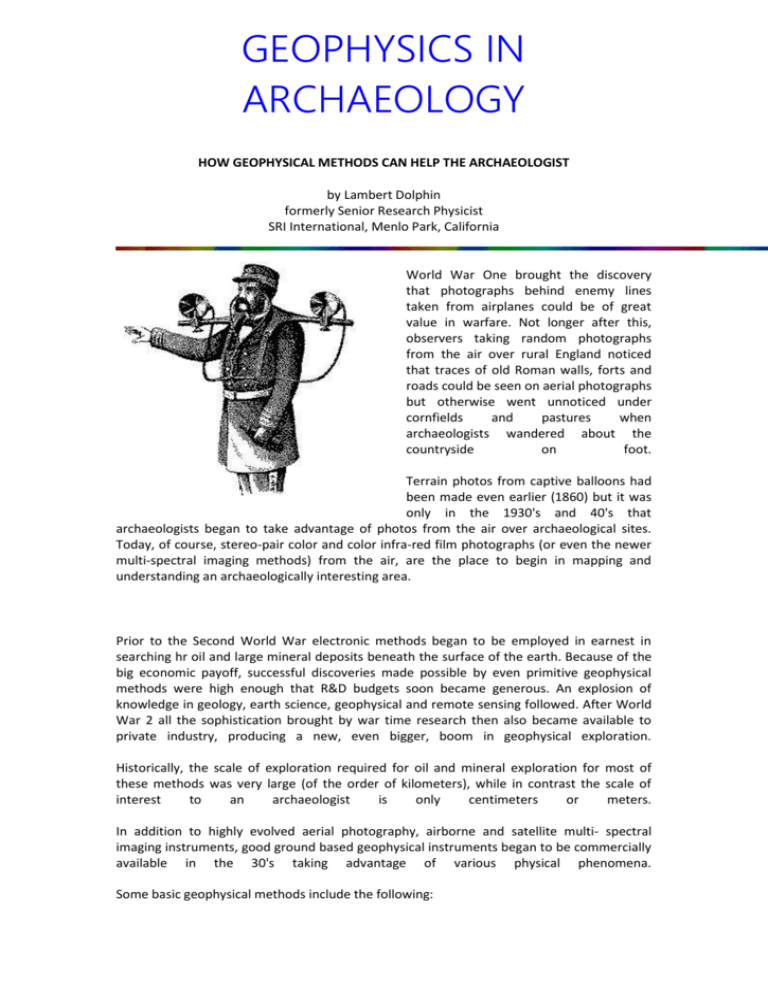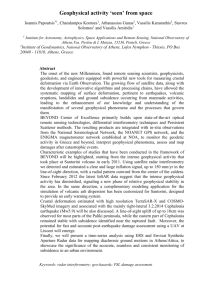GEOPHYSICS IN ARCHAEOLOGY
advertisement

GEOPHYSICS IN ARCHAEOLOGY HOW GEOPHYSICAL METHODS CAN HELP THE ARCHAEOLOGIST by Lambert Dolphin formerly Senior Research Physicist SRI International, Menlo Park, California World War One brought the discovery that photographs behind enemy lines taken from airplanes could be of great value in warfare. Not longer after this, observers taking random photographs from the air over rural England noticed that traces of old Roman walls, forts and roads could be seen on aerial photographs but otherwise went unnoticed under cornfields and pastures when archaeologists wandered about the countryside on foot. Terrain photos from captive balloons had been made even earlier (1860) but it was only in the 1930's and 40's that archaeologists began to take advantage of photos from the air over archaeological sites. Today, of course, stereo-pair color and color infra-red film photographs (or even the newer multi-spectral imaging methods) from the air, are the place to begin in mapping and understanding an archaeologically interesting area. Prior to the Second World War electronic methods began to be employed in earnest in searching hr oil and large mineral deposits beneath the surface of the earth. Because of the big economic payoff, successful discoveries made possible by even primitive geophysical methods were high enough that R&D budgets soon became generous. An explosion of knowledge in geology, earth science, geophysical and remote sensing followed. After World War 2 all the sophistication brought by war time research then also became available to private industry, producing a new, even bigger, boom in geophysical exploration. Historically, the scale of exploration required for oil and mineral exploration for most of these methods was very large (of the order of kilometers), while in contrast the scale of interest to an archaeologist is only centimeters or meters. In addition to highly evolved aerial photography, airborne and satellite multi- spectral imaging instruments, good ground based geophysical instruments began to be commercially available in the 30's taking advantage of various physical phenomena. Some basic geophysical methods include the following: (1) Seismic Reflection & Refraction, (2) Gravity, (3) Magnetics, (4) Electrical, and (5) Radioactivity. Common geophysical instruments and methods include: Earthquake studies (study of the interior of the earth on a large scale). Fibrosis (artificially shaking the ground at low frequencies). Explosion waves with Georgine listening (determines travel time, bending, dispersion, and reflection of low frequency sound waves). Gravimeter (measures variations in the earth's gravity field attributable to sub- surface features). Magnetometer (measures variations in the magnetic field of the earth due to sub-surface features, especially ferrous materials). Resistivity Mapping, Induced Polarization Mapping, Electrical Potential Measurements, Earth Currents (mapping electrical conductivity in the earth). Metal detectors (induced electrical fields). Geiger counter and Scintillation counter (natural radioactive decay of certain earth materials). Neutron Activation (artificially induced radioactive emission). But even with the limited budgets archaeologists have with for decades, geophysical methods can be of great value to an archaeologist. Some of these reasons include: Archaeology is destructive. As a site is dug up it is systematically destroyed, hence each step of the dig must be painstakingly slow with careful documentation at each level. Geophysical probing on the other hand is rapid, non-destructive, and does not disturb the site. Not all archaeological sites can be excavated. Examples would be historic buildings, churches, mosques, the pyramids, parks, and areas which underlie modern urban development. Again, geophysical methods are non- destructive and very rapidly employed, hence often cost effective in the long run. In some cases these methods may be all that the archaeologist is able to use at some sites. Archaeologists can be greatly helped in setting his digging priorities if geophysical methods can be used ahead of time. Geophysical surveying can in many cases reveal artefact-laden vs. barren ground, and disclose important underground features: buried walls, voids, tunnels, ancient streets, etc. Many decades may be required to explore a given site, such as a tell. In fact total excavation of a site may be impractical. Geophysical survey work at a given sites can usually be done in a few days or weeks of effort, the results of which are useful for many years of subsequent excavation work. Salvage archaeology has become important as urban sites encroach on archaeological sites in many parts of the world. Thanks to modern legislation, substantial funding for archaeological research prior to the clearing of an area and construction of new buildings may be available. In many such cases, however, the time available for the archaeological effort may be very limited. Geophysical methods may be of great value as the site will often be totally destroyed by the new construction. NEWER METHODS Ground Penetrating Radar (GPR) was invented in the 1970's, originally for military purposes such as locating land-mines and underground military tunnels. Soon public utility companies began to be keenly interested in such radars in hopes they would provide a practical method for mapping pipes and utility lines under city streets, and for locating cavities and voids. Most recently radars of this type have been used from aircraft for mapping the surface of the earth through jungle or forest cover. GPR technologies have proven to be of great usefulness in archaeology, especially in Israel. Radar from the air is seldom of use to the archaeologist these days except for large sites covered by jungle such as are found in the Yucatan or Central America. Foliage-penetrating radars are now used widely for topographic mapping of the land surface beneath jungle canopy and forest cover. Thermal-infrared imaging methods measure the surface temperature of the earth to an accuracy of a fraction of one degree. The electronic scanning equipment necessary for such measurements was originally available only to the military and the instruments cost from $100,000 to $1,000,000. In recent years portable instruments of great sensitivity have become commercially available at greatly reduced prices. These instruments can be used from a tripod on the ground, or from helicopter or airplane by viewing through a hole in the fuselage. METAL DETECTORS A wide variety of "metal detectors" are commercially available today; they have the advantage of being easy to use and most cost only a few hundred dollars. The larger the search coil, the deeper the penetration; however coins and small metal objects can be detected only a few inches deep and very large metal objects only to depths of a few feet. Non-metal objects are not detected. Some areas are too "noisy" for metal detectors. "Noise" can originate from power lines, or from obscuring signals caused by nearby parked cars, scattered nails, re-bar or metallic litter at the site. Highly mineralized areas are difficult to work in, and certain rocks such as iron-rich basalt can be troublesome for metal detector work. Metal detectors are "active" instruments. A battery-powered transmitter in the unit radiates a relatively low-frequency alternating current signal into the ground by means of a transmitting coil. If the signal from the transmitter encounters any type of conducting metal or mineral in the ground an induced current flows in the subsurface target. This induced current then re-radiates a weak signal back to the surface. The latter signal is out-of-phase with the transmitted signal and thus is easily detected by a receiving coil. Modern metal detectors have circuitry for carefully balancing out any direct signal leakage between transmitter and receiver coils and for discriminating between large and small, shallow or deep, and ferrous or non-ferrous metals. GROUND-PENETRATING RADAR (GPR) Radars designed for probing into the earth typically operate from 30 to 300 MHz-the frequency being determined by the length of the dipole antennas used. It is necessary to use relatively low frequencies because the earth almost always is a good absorber of radar waves. Unfortunately, low frequencies imply long probing wavelengths and long wavelengths imply low resolution. A very short pulse is used allowing accurate measurement of depth to the target, however the antenna beam is very broad (90-120 degrees usually) and can not easily be narrowed because the antennas become too big and bulky. Very often GPRs are mounted on a small wheeled cart which is hand towed across the area of interest, that is, if the search area is reasonably flat and relatively free of brush and boulders. The echoes are displayed in a continuous strip oscilloscope false colour record for ease of interpreting results. In recent years the state of the art in GPR technology has been greatly improved by computer signal processing methods, since the performance of these radars is almost always "clutter limited." Clutter signals are unwanted reflections, off-axis echoes, and multiple scattering echoes. These signals obscure the target of interest under bands of signals but in many cases digital processing improves radar performance by many orders of magnitude. HIGH-FREQUENCY SOUNDING SEISMIC Sound waves are not easily coupled into soils, except at very low frequencies (a few Hertz, or cycles per second) but at higher frequencies sound waves can be used in rock or solid walls as a helpful diagnostic tool. Frequencies used for probing in bedrock or stone are generally 1000 to 30,000 Hertz (cycles/second). A coupling gel, or mud layer, is necessary to couple the seismic signal into and out of the transmitting and receiving transducers and this makes field measurements somewhat time consuming unless only a few locations are to be surveyed. High-frequency sounding is especially useful for finding tombs and voids in areas of high radar signal absorption. For example, the Valley of the Kings in Egypt has very high radar attenuation, but the same limestone can be probed with high-frequency sound waves for distances well beyond 100 feet. Measuring the thickness of a wall or pillar is readily done with this method. Highfrequency seismic sounding instruments are not presently commercially available, but can be custom built for about $10,000. MAGNETOMETRY The earth's magnetic field is slightly disturbed by some kinds of archaeological anomalies such as fired clay pottery. The magnetic signals associated with archaeological features are very small and easily obscured by trash metals, power lines, nearby automobiles, and the like. Magnetometers are most suited for remote, isolated sites away from modern buildings and debris. Magnetometers cost from about $1500 to $10,000 and can be used in pairs (a "differential magnetometer" to subtract out all but the wanted signals. Modern magnetometers are sensitive to field changes of about 1 gamma-the earth's weak magnetic field intensity is of the order of 50,000 gammas. Magnetometry has been successfully used to locate imported stone at some well-known archaeological sites. Fired mud brick has a reasonably high magnetic anomaly and of course ferrous materials such as one might expect at an Iron-Age or later site, give rise to very large magnetic anomalies. AERIAL PHOTOGRAPHY AND IMAGERY Conventional aerial (stereo-pair) photos of a site are very useful, as has been suggested, since outlines and features not visible from the ground frequently show up in aerial photos. Thermal infra-red (IR) imagery requires a scanner, usually cooled by liquid nitrogen, (instrument cost $15,000 to 50,000), but surface temperature differences of a small fraction of one degree can be measured. At night radiation cooling of the ground is not uniform if there are subsurface features that impede or enhance heat flow. In additional to diurnal heating and cooling, seasonal heat flow temperature changes can often be detected providing information on deeper archaeological anomalies. Heat flow through rock and soil is very slow---rock is an excellent heat insulator---so infra- red measurements give information about temperatures near the surface, not about temperatures deep within the earth. In spite of the limitations, false-colour images showing temperature contours can thus provide interesting clues for the archaeologist at some sites, especially if such measurements can be made carefully at periodic intervals through an entire year. The Temple Mount in Jerusalem is an ideal site for on-going thermal infra-red imaging studies and Tuvia Sagiv, an architect from Tel Aviv, has already obtained some fascinating thermal IR images of the Temple Mount area. These can all be done from a distance or from the air. GENERAL COMMENTS If an archaeological site is complex and important, likely to be excavated for many field seasons, geophysical methods can be most useful since they are non-destructive and rapid. The archaeologist can hope to choose digging priorities based on survey findings. Some sites (monuments or parks) contain sites or buildings that can not be disturbed at all, so geophysical sensing may provide the only means of studying the site. Advice from a geologist who is familiar with an area can be helpful also. A combination of geophysical methods can be helpful as each method has its strengths and limitations. Archaeology is a time-honoured exacting scientific discipline which provides us with some of our best information on human history and the past. It is to be hoped that more opportunities and sources of funding will develop so that modern geophysical methods can assist the archaeologist even more frequently than has been possible in recent years.





